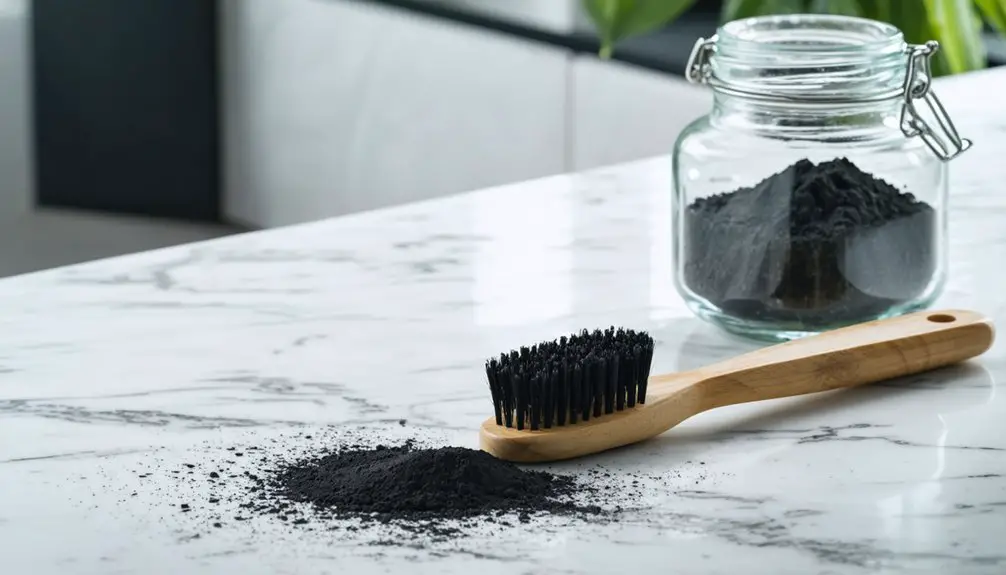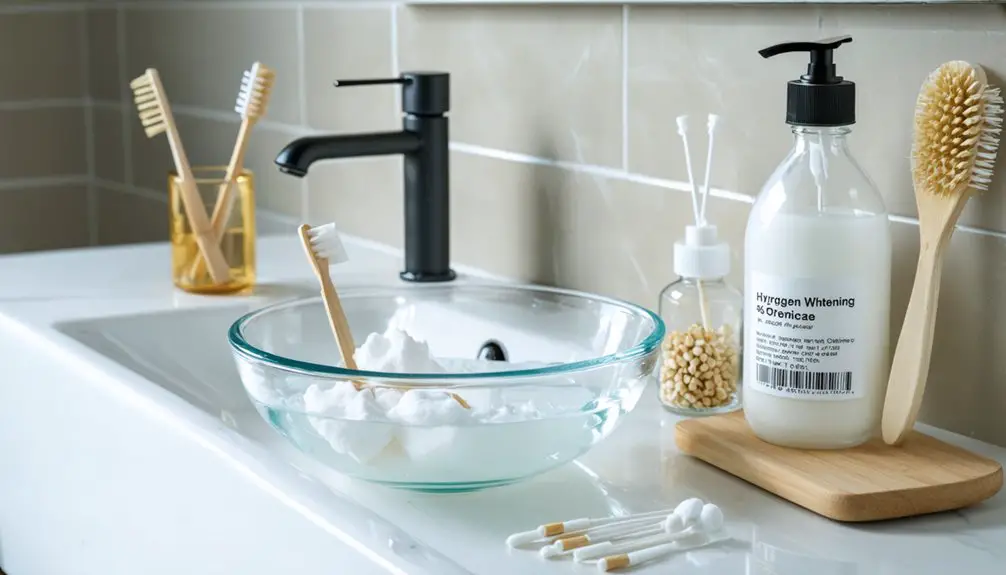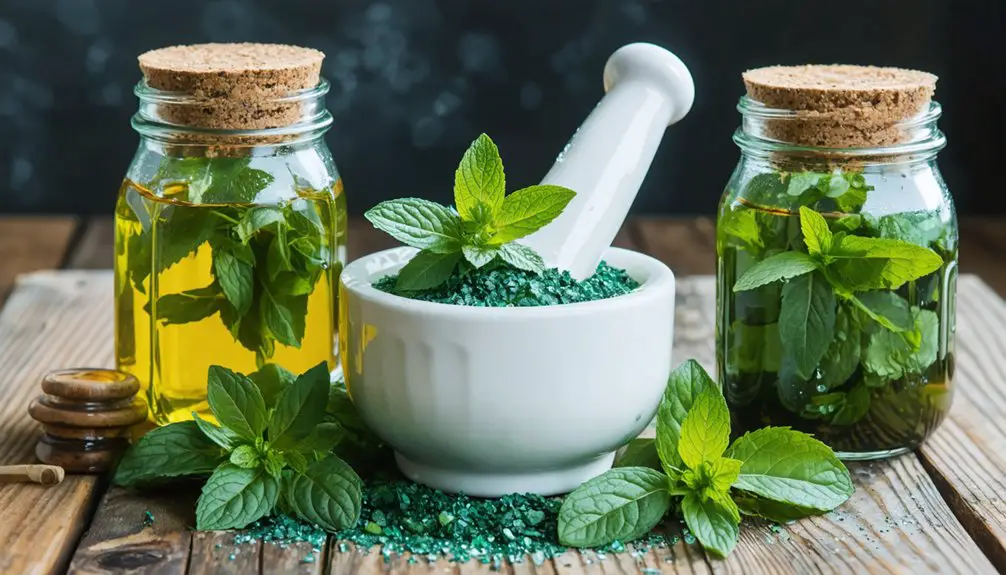Activated charcoal teeth whitening works through natural adsorption and gentle abrasion to remove surface stains from your teeth. While it’s gained popularity as a natural whitening solution, you’ll need to use it cautiously, as its abrasive properties can potentially damage tooth enamel over time. For best results, apply ultra-fine charcoal powder with gentle circular motions for 3 minutes, followed by thorough rinsing. Understanding the science and safety behind this trending treatment will help you make informed choices about your dental care.
Key Takeaways
- Activated charcoal naturally whitens teeth by binding to surface stains through its highly porous structure and negative ionic charges.
- Apply ultra-fine charcoal powder using gentle circular motions for 3 minutes, followed by thorough rinsing and fluoride toothpaste.
- Most charcoal products lack fluoride and can be highly abrasive, potentially damaging tooth enamel with excessive use.
- Professional teeth whitening treatments offer more predictable results and better safety compared to at-home charcoal whitening methods.
- Consider alternative whitening methods like baking soda or peroxide-based strips for gentler, more scientifically proven results.
The Science Behind Activated Charcoal Whitening
Although activated charcoal has gained popularity as a natural teeth whitening solution, its effectiveness relies primarily on physical mechanisms rather than chemical bleaching. The key to its whitening action lies in its adsorption capacity and porous structure, which work together to bind and remove surface stains from your teeth.
When you use activated charcoal products, their high surface area allows them to physically attract and trap chromophores – the compounds responsible for tooth discoloration. The negative ionic charges in charcoal naturally pull positively charged stain molecules from your tooth surfaces. The process requires 3-5 minutes of brushing to achieve any noticeable stain removal effects.
However, you’ll find this process mainly affects extrinsic stains, as charcoal can’t penetrate deep into your enamel to address intrinsic discoloration. While social media trends have fueled its widespread adoption, scientific evidence supporting its effectiveness remains limited. For enhanced stain removal, many products combine charcoal with abrasive components like silica.
Safety Considerations and Potential Risks
While activated charcoal’s stain-removing properties have sparked widespread interest, its safety profile raises significant concerns among dental professionals.
The highly abrasive nature of charcoal can lead to enamel erosion, permanently damaging your teeth’s protective layer. Once enamel wears away, it exposes the yellowish dentin underneath, potentially worsening the appearance you’re trying to improve. A 2019 review showed limited clinical evidence for charcoal’s whitening effectiveness. Tooth powders containing charcoal can be five times more abrasive than standard toothpaste.
You’ll also need to evaluate the risk of gum irritation from charcoal particles, which can cause inflammation and sensitivity.
Most charcoal products lack fluoride, leaving your teeth vulnerable to decay. If you’re pondering this treatment, be aware that its whitening effectiveness is limited to surface stains, and charcoal particles may become trapped in small cracks, causing unwanted staining.
Always consult your dentist before starting any charcoal-based dental routine.
Professional vs. At-Home Charcoal Treatments
When choosing between professional and at-home charcoal treatments, you’ll encounter significant differences in their whitening mechanisms and effectiveness.
Professional treatments utilize peroxide-based agents that penetrate deep into your enamel, while activated charcoal primarily works on surface stains through adsorption. Regular use of charcoal treatments can lead to enamel erosion over time. Most charcoal toothpastes are missing fluoride, which is essential for cavity prevention.
Don’t fall for common whitening myths about charcoal’s effectiveness. While charcoal can bind to surface plaque and neutralize acids, it won’t provide the same uniform, long-lasting results as professional treatments.
Professional whitening occurs under dental supervision with controlled application and protective agents to minimize sensitivity. In contrast, at-home charcoal treatments lack standardization and can potentially damage your enamel through abrasive action.
For ideal results, consider using charcoal products occasionally as a supplement to professional treatments rather than a primary whitening method.
Maximizing Results: Best Practices and Usage Tips
To achieve ideal whitening results with activated charcoal, proper application techniques and consistent care routines are paramount. You’ll need to focus on gentle circular brushing motions while maintaining the right frequency guidelines to protect your enamel’s integrity. Our formula containing pure coconut charcoal provides safe, natural whitening power without harsh chemicals. Because activated charcoal works through its porous structure binding, it effectively captures surface stains and plaque buildup.
- Apply ultra-fine charcoal powder with a soft-bristled brush for 3 minutes, using gentle circular motions to effectively lift surface stains without damaging your teeth.
- Limit daily treatments and monitor for sensitivity, adjusting usage frequency as needed to prevent enamel wear.
- Follow each treatment with thorough rinsing and regular fluoride toothpaste to maintain peak oral health.
Remember to complement your charcoal whitening routine with professional dental cleanings and lifestyle modifications to minimize re-staining.
This balanced approach will help you achieve and maintain your desired results safely.
Alternative Whitening Methods Worth Considering
Although activated charcoal has gained popularity, several proven alternatives offer reliable teeth whitening results. Among natural alternatives, baking soda provides gentle stain removal without damaging your enamel, making it a safe option for your patients. Studies show tooth sensitivity affects over 50% of patients using peroxide-based whitening products.
You’ll find that whitening strips containing low concentrations of hydrogen peroxide deliver consistent results for mild staining, especially when used as directed over a two-week period. Clinical studies show that 10% carbamide peroxide provides significantly better whitening results compared to most other treatments.
For more dramatic results, you can recommend professional in-office treatments using higher peroxide concentrations. These deliver immediate improvements, though you should advise patients about potential temporary sensitivity.
When discussing consumer preferences with patients, consider suggesting whitening toothpastes that combine mild abrasives with chemical agents – they’re effective for gradual whitening and cause minimal sensitivity while being convenient for daily use.
Frequently Asked Questions
Can Activated Charcoal Toothpaste Remove Stains From Dental Crowns or Veneers?
Professional prudence prevails: You shouldn’t use activated charcoal for stain removal on dental materials like crowns or veneers. It won’t whiten them and can actually damage or discolor your restorations.
How Long Should I Wait After Professional Teeth Cleaning to Use Charcoal?
You should wait at least 2 weeks post-cleaning to minimize teeth sensitivity. For ideal charcoal safety, consult your dentist first, as individual healing times vary based on your oral health.
Will Activated Charcoal Stain My Tongue or Gums Temporarily?
Yes, you’ll notice temporary discoloration on your tongue and gums. Don’t worry – it’s harmless and will disappear with normal oral hygiene like brushing, flossing, and thorough rinsing with water.
Can I Mix Activated Charcoal Powder With My Regular Fluoride Toothpaste?
Don’t mix activated charcoal with fluoride toothpaste. There’s no proven benefits, and it may reduce fluoride’s protective effects. You’ll risk damaging your enamel and compromising your oral health through increased abrasiveness.
Does Drinking Through a Straw Prevent Charcoal Stains on Teeth?
While straw benefits help prevent liquid stains, they won’t stop charcoal absorption or residue from staining your teeth. You’ll need thorough rinsing to remove any remaining charcoal powder.
References
- https://jdsits.in/archive/volume/13/issue/1/article/10215/pdf
- https://www.todaysrdh.com/activated-charcoal-in-toothpaste-systematic-review-looks-at-whitening-and-abrasive-effects/
- https://rsdjournal.org/index.php/rsd/article/view/22809
- https://pubmed.ncbi.nlm.nih.gov/36183933/
- https://pmc.ncbi.nlm.nih.gov/articles/PMC10351494/
- https://pubmed.ncbi.nlm.nih.gov/38316199/
- https://mavedds.com/cosmetic-dentistry-blog/the-latest-diy-whitening-trend-charcoal-teeth-whitening
- https://www.oldsettlersdental.com/demystifying-charcoal-teeth-whitening-all-you-need-to-know/
- https://www.gatewaydentistrygroup.ca/activated-charcoal-teeth-whitening/
- https://smilevancouver.ca/blog/charcoal-teeth-whitening-dangers/



